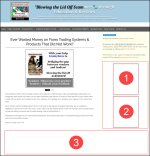- Home
- Forex Articles
- Forex Trading
- How to make a simple start in Forex trading
How to make a simple start in Forex trading
by Zahir Shah
In this short article we can't possibly cover all the basics involved when considering trading Forex as a supplementary income to the meagre rates of interest savers currently receive from their bank deposits, or for those amongst us considering Forex trading as a potential career, part time, or eventually as a full time occupation. Therefore we'll just deliver a few simple tips as to how to get up and running.
What is Forex trading?
Understanding what forex trading is should be a simple concept to take on board, given that we're used to exchanging our domestic currency (let's refer to it as our base currency), for our holiday currency (let's call it our counter currency), on a regular basis. We know that the rate of exchange differs and even those of us who aren't exactly sure why it varies, will have a rough idea that it relates to the performance, or potential performance of our economy, versus the performance of our destination's economy.
We therefore 'trade' that fluctuation when we change our currency, which is determined by the overall sentiment of the U.K. pound. How we trade the currency pair, in this instance our GBP/AUD, is a far more complex discussion for a later date.
Broker choice
Picking your Forex broker shouldn't prove to be difficult process; they should operate an STP/ECN business/trading model, not charge for rollovers/swaps, or commissions and have consistently low spreads. They must also have excellent lines of communication; verbal and through their website. You should also establish if they have a trader school, that they print regular trading updates and generally be constantly looking to help their clients prosper.
Platform familiarization
It can take years of part time involvement to become fully conversant with a superb world class retail platform such as MetaTrader 4, however, it's incredibly simple to make a start with. Developing your understanding of it and coming to terms with all the: features, benefits and complexity is a marathon not a sprint. But starting with it and keeping with it, is one of the wisest decisions we can make as novice traders.
What pairs to trade?
Identifying what pairs to trade shouldn't prove to be a confusing process, as when you begin trading as a novice, you may choose to trade what's termed the four "major currency pairs", recognised as:
EUR/USD (euro/dollar) – "euro"
USD/JPY (U.S. dollar/Japanese yen) – "gopher"
GBP/USD (British pound/dollar) - "cable"
USD/CHF (U.S. dollar/Swiss franc) – "swissie"
Let's choose one as an example; the EUR/USD, commonly referred to as "trading the euro". It's the most traded currency pair (accounting for approx. 50% of trading according to the latest BIS data). As the most traded pair you'll experience more competitive spreads, experience more precise fills and less slippage. In simple terms; the majority of the time you trade your order will be executed as close to the quote you observe on your chart.
At the outset the majority of experienced traders and tutors would suggest that you stick to trading only this one pair singularly for the first few months, as once you've become familiar with: your platform, your broker, and how to place simple trades, you can then move 'through the gears', to add further complexity to your trading.
Levels of Risk
The level of risk you apply to each trade/order you place into the market should remain consistent. If you begin trading by funding your account with a €500 deposit then you should think of limiting your risk to just 1%, just €5 per trade and there are many brokers who'll happily oblige with this level of micro trading, without penalising you by way of increased charges, or excessive spreads.
When to trade
Identifying when to trade and what style of trading you initially adopt is critical. When you begin trading with a micro account, you'll more than likely be a part time trader, fitting in trading with you lifestyle and job. Therefore you may be best analysing the market for EUR/USD at the end of each day, identifying what you perceive to be a pattern, reading the upcoming, daily economic calendar events and deciding on a direction to trade.





